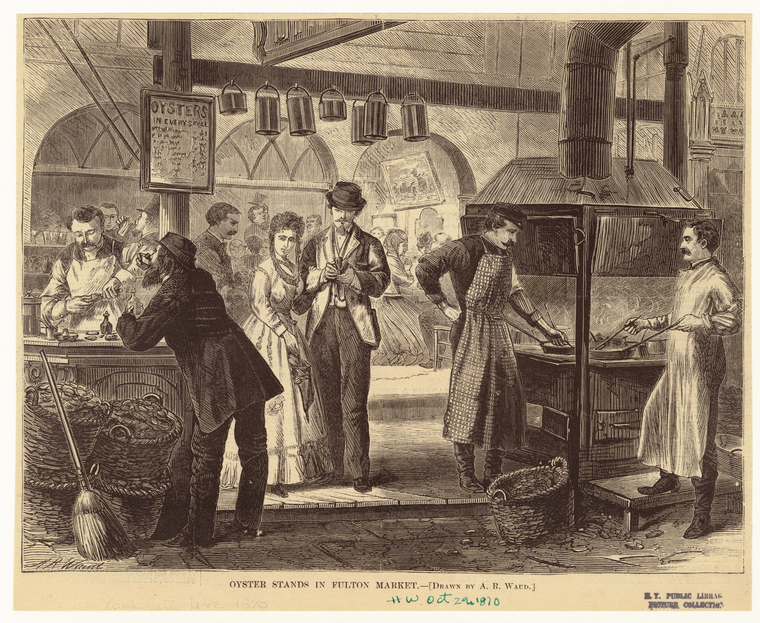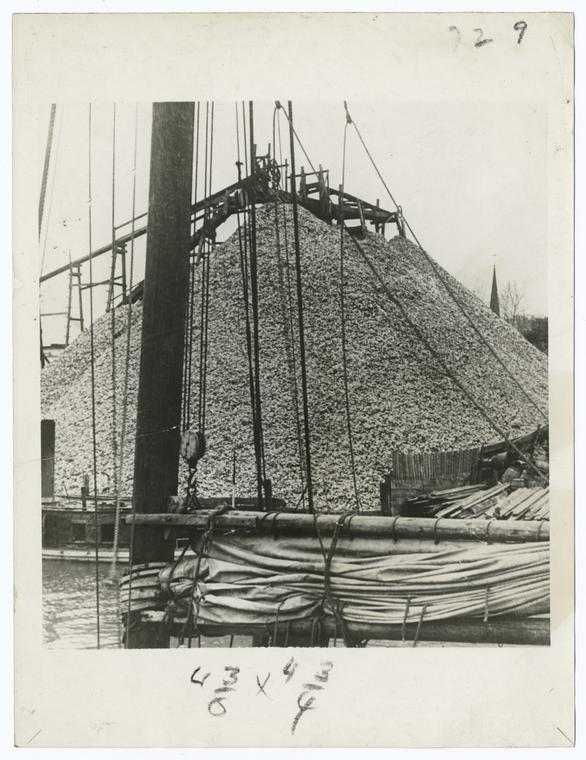What's on the Menu?, Food for Thought
History on the Half-Shell: The Story of New York City and Its Oysters

Blue Points, Saddle Rocks, Rockaways, Lynnhavens, Cape Cods, Buzzard Bays, Cotuits, Shrewsburys—raw on the half shell. Fried oysters, oyster pie, oyster patties, oyster box stew, Oysters Pompadour, Oysters Algonquin, Oysters a la Netherland, a la Newberg, a la Poulette, oysters roasted on toast, broiled in shell, served with cocktail sauce, stewed in milk or cream, fried with bacon, escalloped, fricasseed, and pickled. If you have spent any time transcribing for NYPL's What’s on the Menu? project, you’ve seen a lot of ways to prepare this humble bivalve.
![26TH ANNIVERSARY BANQUET [held by] KNIGHTS OF REVELRY [at] "GERMAN RELIEF HALL, MOBILE AL" (OTHER (PRIVATE CLUB?);), Digital ID 466978, New York Public Library 26TH ANNIVERSARY BANQUET [held by] KNIGHTS OF REVELRY [at] "GERMAN RELIEF HALL, MOBILE AL" (OTHER (PRIVATE CLUB?);), Digital ID 466978, New York Public Library](https://images.nypl.org/?id=466978&t=w)
In a comprehensive history of the oyster in New York, The Big Oyster, author Mark Kurlansky wrote, “the history of the New York oyster is a history of New York itself—its wealth, its strength, its excitement, its greed, its thoughtfulness, its destructiveness, its blindness, and—as any New Yorker will tell you—its filth.” It was pollution and over-harvesting that killed the oyster industry in in New York, a surprising feat considering that the lower Hudson estuary once had 350 square miles of oyster beds and some biologists estimate that the New York Harbor contained half of the the world’s oysters2.

![DINNER [held by] DELMONICO'S [at] "NEW YORK, NY" (HOT;), Digital ID 467541, New York Public Library DINNER [held by] DELMONICO'S [at] "NEW YORK, NY" (HOT;), Digital ID 467541, New York Public Library](https://images.nypl.org/?id=467541&t=w)
Oysters were by no means limited to nice restaurants, or even oyster cellars. Street vending of oysters, along with hot corn, peanuts, and buns, was part of New York’s regular food distribution system. While visiting New York in the 1790s, the Frenchman Moreau de St. Mery commented, “Americans have a passion for oysters, which they eat at all hours, even in the streets.” Oysters were regular fare at cheap eateries, and it was claimed that the very poorest New Yorkers “had no other subsistence than oysters and bread.”1 Fortunately, oysters are nutritious—rich in protein, phosphorus, iodine, calcium, iron, and vitamins A, B, and C.5
![[Oyster boat Nettie C. Powell at Fulton Street dock.],Occupations - Peddlers - General food vendors - Oysters., Digital ID 732406F, New York Public Library [Oyster boat Nettie C. Powell at Fulton Street dock.],Occupations - Peddlers - General food vendors - Oysters., Digital ID 732406F, New York Public Library](https://images.nypl.org/?id=732406F&t=w)
An interesting specialty that also appeared on New York menus was terrapin. The terrapin, considered exotic even in an age when calf brains were regularly seen on menus, was “unique among turtles because it lives in the same brackish tidal waters as the clams and oysters upon which it feeds.” Later served in upper class restaurants with wine sauce or a la Maryland, terrapin was once served in taverns cooked in the style that the Lenape had used: roasted whole over an open fire2. Naturally, the terrapin disappeared off of menus when their own diet of New York harbor oysters became polluted.
Though the original oyster population was capable of filtering all of the the water in New York Harbor in a matter of days, it was not an unlimited resource. In 1658, New Amsterdam’s Dutch Council had already limited when and from where oysters could be gathered because of over-harvesting. As early as 1704, residents of Rockaway attempted to regulate oystering in their waters to locals only. New Yorkers made a lot of mistakes with oystering - for example, it took a remarkably long time to figure out that the best thing to do with oyster shells is to dump them back onto oyster beds. Previously they had been burned, placed in piles, or turned into mortar paste to aid NY’s building boom. Trinity Church is an example of a building built with oyster-shell mortar paste.

New York’s oysters were too polluted to eat by 1927, and pollution only increased in subsequent years. It was not until after 1972’s Clean Water Act that any improvements were seen, but the oysters are still not edible almost 40 years after the passage of that act. Dredging stirs up centuries worth of pollution lying thickly upon the harbor floor. But one thing is certain, replacing the oyster beds will only help aid the rehabilitation of the harbor. Though the oysters can do nothing about harmful PCBs and heavy metals (which is why we still shouldn’t eat them), they can quickly cleanse organic wastes from the water. Major efforts to restore New York’s oyster population are underway.
* * *
Join the menu transcription effort at What's on the Menu?
Sources for this article:
- Gastropolis: Food and New York City.
- The Big Oyster by Mark Kurlansky
- "Before there were bagels, New York had the oyster" by William Grimes, New York Times; retrieved via Gale Group New York Times 1985-present.
- "Mr. Downing and his oyster house: the life and good works of an African-American entrepreneur" by John H. Hewitt, American Visions; retrieved via Academic OneFile.
- "Oyster" - via Grolier Online.
Read E-Books with SimplyE
 With your library card, it's easier than ever to choose from more than 300,000 e-books on SimplyE, The New York Public Library's free e-reader app. Gain access to digital resources for all ages, including e-books, audiobooks, databases, and more.
With your library card, it's easier than ever to choose from more than 300,000 e-books on SimplyE, The New York Public Library's free e-reader app. Gain access to digital resources for all ages, including e-books, audiobooks, databases, and more.
If you don’t have an NYPL library card, New York State residents can apply for a digital card online or through SimplyE (available on the App Store or Google Play).
Need more help? Read our guide to using SimplyE.
Comments
Fantastic Post!
Submitted by shawndonohue (not verified) on June 2, 2011 - 4:26pm
Food History
Submitted by Keith (not verified) on July 1, 2011 - 3:08pm
Oysrers (& Clams)
Submitted by Paul Georges (not verified) on September 6, 2011 - 7:41pm
Oysters in NYC
Submitted by Ruth (not verified) on September 19, 2011 - 2:54pm
Hi Ruth, I am doing research
Submitted by Helena (not verified) on September 16, 2015 - 12:20pm
Oysters
Submitted by Deborah (not verified) on April 28, 2019 - 8:15pm
Oysters!
Submitted by Thomas feaster (not verified) on February 25, 2017 - 9:45pm
Oysters
Submitted by Jon Randall Dur... (not verified) on August 20, 2017 - 9:52am
Oystering in NYC and Long Island
Submitted by Barbara Rossman (not verified) on December 22, 2018 - 6:22pm